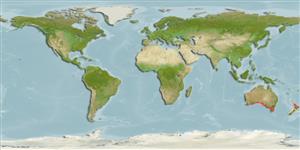Environment: milieu / climate zone / depth range / distribution range
นิเวศวิทยา
เกี่ยวกับทะเล,น้ำเค็ม เกี่ยวกับหินโสโครก; ระดับความลึก 2 - 140 m (Ref. 9563). Temperate
Eastern Indian Ocean to Southwest Pacific: off southeastern and southern coasts of Australia.
ขนาด / น้ำหนัก / Age
Maturity: Lm ? range ? - ? cm
Max length : 40.0 cm TL เพศผู้/กระเทย; (Ref. 9563)
Short description
เครื่องมือที่ใช้ในการแยกชนิดสัตว์,สิ่งมีชีวิตออกจากกัน | สัณฐานวิทยา | ความยาวต่างๆ
เงี่ยงครีบหลัง (รวม) : 8; ก้านครีบอ่อนที่หาง (รวม) : 8; เงี่ยงครีบก้น: 3; ก้านครีบอ่อนที่ก้น: 5; สัตว์มีกระดูกสันหลัง: 25 - 26. Diagnosis: Dorsal rays XIII, 8 (7 in 1 of 102 specimens), third spine longest. Anal rays III, 5 (4 or 6 in 2 of 102 specimens). Pectoral rays 19-22 (mode 21), distal margin rounded. Pored lateral-line scales 38-50 (46); longitudinal scale series 72-103 (80); scale rows between base of last dorsal spine and lateral line 7-10 (9). Well-developed gill rakers on upper limb 0-6 (1), lower limb 5-10 (7), total 6-13 (8); rudimentary gill rakers on upper limb 0-7 (4), lower limb 2-8 (5). Swim bladder bilobed anteriorly (length 31 % of SL, width 23% of SL, bilobed portion 40% of total swim bladder length). Dorsal profile of snout steep, forming angle of about 60-70° to horizontal axis of head and body. Nasal spine simple, small, directed upward or slightly backward, length of former approximately equal to or less than anterior nostril diameter. Posterior margin of premaxilla ascending process just short of or extending slightly beyond level of anterior margin of posterior nostril when mouth closed. Interorbital ridge indistinct; no scales on midinterorbital space, but scales present on supraorbital bone; interorbital space deep, about one-eighth of orbit extending above dorsal profile of head. Preocular with a small simple spine, its length approximately equal to or less than that of nasal spine. Supraocular ridge with 1-7 blunt spines, canted laterally; supraocular ridge much closer to orbit than interorbital ridge in dorsal view. Sphenotic with a serrated spine in upper and 3-27 minute pointed spines in lower. Postorbital spine flattened and serrated. Narrow transversal occipital pit present, but not deep, with a few scales (fully scaled in some specimens); occipital pit curved posteriorly behind orbit, not covered with scales. Nuchal and pterotic spines simple, distal margins serrated (rarely smooth); origin of nuchal spine slightly anterior to that of pterotic spine, base slightly larger than or equal to (rarely smaller than) that of latter. Upper posttemporal spine flattened and serrated; lower posttemporal spine simple (sometimes with 2 or 3 points). Supracleithral spine with 1-4 points. Posterior margin of maxilla not reaching a vertical at posterior margin of orbit (usually just reaching posterior margin of pupil); maxilla with scales extending posteriorly from under anterior margin of anterior lacrimal spine, but no scales on posterior margin. Underside of mandible with numerous tiny pores, no ridges. Lacrimal ridge with 1-5 points (sometimes smooth); anterior lacrimal spine with 2-4 points, directed downward, its tip not reaching or just reaching dorsal edge of upper lip when mouth closed; posterior lacrimal spine with 3-7 points, directed ventro posteriorly, its anterior tip not reaching dorsal edge of upper lip; length of anterior lacrimal spine 1.5 times or more in that of posterior lacrimal spine. Suborbital pit present, front rimmed by a oblique or vertical ridge on lacrimal to ventroanterior margin of orbit; scales present on entire suborbital pit. Suborbital ridge with 2 pointed spines in line with lacrimal ridge, spines separated at bases, directed backward; 1 or 2 spines sometimes arising from each suborbital spine; 1 or 2 scales present between ventral margin of orbit and suborbital ridge. Suborbital scales not extending onto eye membrane. Preopercle with 4 spines (rarely 5-7 spines), 3 lower spines simple (sometimes with 2-3 points on each spine; with 3-7 points in larger specimens), lacking median ridge, uppermost spine with a median ridge and with 1-4 spines distally (rarely an additional small spine present above usual uppermost spine); length of uppermost preopercular spine approximately equal to pupil diameter; upper opercular spine simple, lacking median ridge; lower opercular spine simple with a median ridge; tip of lower opercular spine not extending beyond opercular margin (Ref. 54394).
Generally demersal on the continental shelf (Ref. 9563). Found on rocky reefs in coastal waters (Ref. 33616); particularly sponge areas in sandy patches (Ref. 54394). Adults have a curved lateral line near the dorsal-fin base and long, venomous dorsal-fin spines (Ref. 33616).
Life cycle and mating behavior
วัยเจริญพันธุ์ | การสืบพันธุ์ | การวางไข่ | เซลสืบพันธ์ของเพศเมีย(ไข่) | ความดกของไข่ | ตัวอ่อน
Motomura, H., 2003. Revision of the scorpionfish genus Neosebastes (Scorpaeniformes: Neosebastidae), with descriptions of five new species. Indo-Pac. Fish. (37):46 p. (Ref. 54394)
IUCN Red List Status (Ref. 130435: Version 2024-1)
Human uses
เครื่องมือ
Special reports
Download XML
แหล่งที่มาจากอินเตอร์เน็ต
Estimates based on models
Preferred temperature (Ref.
123201): 14.5 - 18.4, mean 16.4 °C (based on 276 cells).
Phylogenetic diversity index (Ref.
82804): PD
50 = 0.5002 [Uniqueness, from 0.5 = low to 2.0 = high].
Bayesian length-weight: a=0.01995 (0.00906 - 0.04395), b=3.01 (2.83 - 3.19), in cm total length, based on all LWR estimates for this body shape (Ref.
93245).
ระดับชั้นอาหาร (Ref.
69278): 3.8 ±0.4 se; based on size and trophs of closest relatives
Fishing Vulnerability (Ref.
59153): Low to moderate vulnerability (30 of 100).
Nutrients (Ref.
124155): Calcium = 14.9 [6.2, 31.5] mg/100g; Iron = 0.202 [0.094, 0.399] mg/100g; Protein = 17.8 [16.2, 19.4] %; Omega3 = 0.417 [0.170, 1.378] g/100g; Selenium = 10.5 [4.7, 24.8] μg/100g; VitaminA = 36.1 [8.1, 174.5] μg/100g; Zinc = 0.531 [0.339, 0.836] mg/100g (wet weight);
